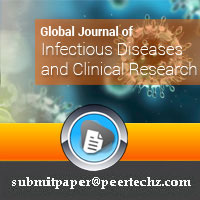Global Journal of Infectious Diseases and Clinical Research
Febrile consumptive syndrome after prostatectomy
Ana Margarida Barrigó Fernandes Bernardo*, Susana Escária and Sara Correia
Cite this as
Fernandes Bernardo AMB, Susana Escária, Correia S (2020) Febrile consumptive syndrome after prostatectomy. Glob J Infect Dis Clin Res 6(1): 001-002. DOI: 10.17352/2455-5363.000025Introduction
A 75-year-old male patient came to the emergency department, referring high fever with nocturnal predominance and profuse sweating. He also referred asthenia, anorexia, and weight loss of 20kg in the past month, with onset after prostatectomy due to a benign prostatic hyperplasia. He had a previous history of chronic lymphocytic leukemia and type 2 Diabetes mellitus.
The initial observation at the Emergency Department revealed a tympanic temperature of 39ºC with no other changes. Laboratory tests showed thrombocytopenia, hyperlactacidemia, and increased inflammatory markers (table 1). On the chest X-ray, a diffuse interstitial enhancement was identified. He was admitted to the Medical Ward assuming a febrile consumptive syndrome of unknown etiology.
The cardiac ultrasound showed no changes and the whole-body CT scan presented a lung reticulonodular pattern with no cavities (Figure 1).
On consulting the prostate histological examination report, we were surprised by the presence of changes suggestive of necrotizing granulomatous prostatitis with identification of acid-alcohol resistant bacillae and thereafter, the blood culture showed the presence of Mycobacterium tuberculosis.
Figure 1: Thoracic image of the CT scan showing reticulonodular pattern.
Discussion
The diagnosis was Prostatic Tuberculosis with hematogenous dissemination.
The patient was started on antibacillary therapy and Piperacillin/Tazobactam, and showed clinical improvement towards a full recovery.
Tuberculosis is an infectious disease with a high worldwide rate of morbidity and mortality, being associated with situations of immunosuppression. It generally presents with unspecific symptoms that can often lead to a delay in its diagnosis.
Prostatic tuberculosis is a rare clinical entity, which can go unnoticed. In this case, the lack of a correct diagnosis before the prostatectomy resulted in the hematogenous dissemination of the bacillae, leading to an infection difficult to control.
The importance of this case disclosure is due to its rarity and severity and shows the importance of considering the diagnosis of urogenital tuberculosis in patients presenting with urinary symptoms and prostatic imagiologic changes.
This patient is from Alentejo, an interior region of Portugal, which, despite being a developed country, has a considerable prevalence of tuberculosis.
Article Alerts
Subscribe to our articles alerts and stay tuned.
 This work is licensed under a Creative Commons Attribution 4.0 International License.
This work is licensed under a Creative Commons Attribution 4.0 International License.


 Save to Mendeley
Save to Mendeley
